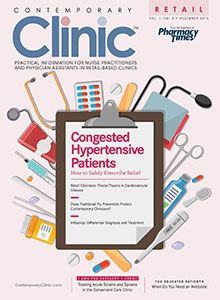Breast-Feeding Can Lower the Risk of Developing Cancer
Recent data has shown an inverse relationship between cancer and breast-feeding.
In addition to aiding in postpartum weight loss, breast-feeding offers other health benefits for mothers, according to recent data published inCancer Epidemiologyshowing an inverse relationship between cancer and breast-feeding.
Globally, breast cancer is the most common cancer among women. Research indicates that women who breast-feed are less likely to get breast cancer, and possibly, ovarian and endometrial cancers. The European Code against Cancer recommends breast-feeding, noting that it can reduce the mother’s cancer risk. Research by the international Collaborative Group on Hormonal Factors in Breast Cancer shows that breast-feeding carries a 4.3% risk reduction for every 12 months of cumulative breast-feeding (in addition to an estimated 7.0% reduction in risk for each birth). In addition, a study by the Continuous Update Project of the World Cancer Research Fund showed a decreased breast cancer risk of 2% for an increase of 5 months of total breast-feeding.
Research seems to suggest that exclusive breast-feeding, defined as the baby receiving only breast milk for a period of time, lowers the incidence of ovarian and endometrial cancers as well, although more research is needed to make a definitive statement on the matter.
Possible causes of reduction in cancer rates due to breast-feeding are postponement of the menstrual cycle, reduction of estrogen level in the breasts, and full differentiation of breast tissue, which makes it less susceptible to hormonal changes that can increase the chances for mutation. The exfoliation of breast tissue that breast-feeding causes can also decrease cancer risk by removing damaged DNA.
It is recommended to breast-feed babies the as long as possible. Exclusive breastfeeding may have benefits in preventing ovarian and endometrial cancers, in addition to breast cancer. This, along with known metabolic benefits and bonding time between mother and baby, presents a strong case in favor of breast-feeding infants.

Knock Out Aches and Pains From Cold
October 30th 2019The symptoms associated with colds, most commonly congestion, coughing, sneezing, and sore throats, are the body's response when a virus exerts its effects on the immune system. Cold symptoms peak at about 1 to 2 days and last 7 to 10 days but can last up to 3 weeks.
COPD: Should a Clinician Treat or Refer?
October 27th 2019The Global Initiative for Chronic Obstructive Lung Disease (GOLD) defines the condition as follows: “COPD is a common, preventable, and treatable disease that is characterized by persistent respiratory symptoms and airflow limitation that is due to airway and/or alveolar abnormalities usually caused by significant exposure to noxious particles or gases.â€
Diabetic Ketoacidosis Is Preventable With Proper Treatment
October 24th 2019Cancer, diabetes, and heart disease account for a large portion of the $3.3 trillion annual US health care expenditures. In fact, 90% of these expenditures are due to chronic conditions. About 23 million people in the United States have diabetes, 7 million have undiagnosed diabetes, and 83 million have prediabetes.
What Are the Latest Influenza Vaccine Recommendations?
October 21st 2019Clinicians should recommend routine yearly influenza vaccinations for everyone 6 months or older who has no contraindications for the 2019-2020 influenza season starting at the end of October, according to the Advisory Committee on Immunization Practices.
What Is the Best Way to Treat Pharyngitis?
October 18th 2019There are many different causes of throat discomfort, but patients commonly associate a sore throat with an infection and may think that they need antibiotics. This unfortunately leads to unnecessary antibiotic prescribing when clinicians do not apply evidence-based practice.
